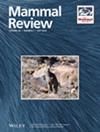Wild felids in trophic cascades: a global review
IF 4.3
2区 生物学
Q1 ECOLOGY
引用次数: 0
Abstract
- Carnivores, often identified as keystone species, can influence prey and subordinate carnivores through density- and behaviourally mediated pathways. Although the magnitude of their impacts remains debated, carnivores may trigger successional direct and indirect ecological effects on lower trophic levels in specific contexts, commonly known as trophic cascades. Felids, as ambush predators, have great potential to impact food webs. Yet, their influence on ecosystem dynamics remains understudied.
- This global comprehensive literature review aimed to assess evidence for felids' ecological roles in trophic cascades across both natural and human-dominated ecosystems.
- We found 61 publications that studied the influence of 18 felid species in trophic cascades. Research exhibited taxonomic and geographic biases, favouring big cats, temperate regions and biomes, as well as tropical moist forests in Central and South America. Of the studies, 23% (n = 14) were experimental, while 77% were observational or correlative. Among the latter, 60% tested at least one alternative hypothesis and 47% examined bottom-up processes.
- Despite varying levels of inference, 80% of studies provide information consistent with trophic cascades involving felids. Their examination confirmed wild cats' ability to induce density- and behaviourally mediated trophic cascades, thereby influencing critical biotic and abiotic processes, including mesopredator control, functional diversity maintenance, and carbon storage. The magnitude of these effects may be altered in human-dominated landscapes, although current research effort remains too limited to draw conclusions.
- In conclusion, felids may act as drivers of ecosystem change, and acknowledging their ecological roles can aid in promoting their conservation. However, we encourage more strongly inferential and comprehensive investigations into felid-mediated trophic cascades, prioritising research on small cats, felids in Asia and Africa, and the impacts of humans on trophic cascades, which can help to better inform conservation interventions and perspectives.

营养级联中的野生猫科动物:全球综述
食肉动物通常被认为是关键物种,它们可以通过密度和行为中介途径影响猎物和从属食肉动物。尽管对其影响的大小仍有争议,但食肉动物可能会在特定情况下对较低营养级(通常称为营养级联)产生直接和间接的生态效应。猫科动物作为伏击捕食者,对食物网的影响潜力巨大。然而,它们对生态系统动态的影响仍未得到充分研究。这篇全球性综合文献综述旨在评估猫科动物在自然和人类主导的生态系统中营养级联中的生态作用证据。我们发现有 61 篇文献研究了 18 种猫科动物在营养级联中的影响。研究显示了分类学和地理学上的偏差,偏爱大型猫科动物、温带地区和生物群落以及中美洲和南美洲的热带潮湿森林。在这些研究中,23%(n = 14)为实验性研究,77%为观察性或相关性研究。在后者中,60%的研究测试了至少一个替代假设,47%的研究考察了自下而上的过程。尽管推论的程度不同,但80%的研究提供的信息与涉及猫科动物的营养级联相一致。他们的研究证实,野生猫科动物有能力诱发密度和行为介导的营养级联,从而影响关键的生物和非生物过程,包括中层食肉动物控制、功能多样性维持和碳储存。在人类占主导地位的景观中,这些影响的程度可能会发生变化,但目前的研究工作仍然太有限,无法得出结论。总之,猫科动物可能是生态系统变化的驱动力,承认它们的生态作用有助于促进对它们的保护。然而,我们鼓励对猫科动物介导的营养级联进行更有力的推断和更全面的调查,优先研究小型猫科动物、亚洲和非洲的猫科动物以及人类对营养级联的影响,这有助于更好地为保护干预措施和观点提供信息。
本文章由计算机程序翻译,如有差异,请以英文原文为准。
求助全文
约1分钟内获得全文
求助全文
来源期刊

Mammal Review
生物-动物学
CiteScore
12.20
自引率
4.10%
发文量
29
审稿时长
>12 weeks
期刊介绍:
Mammal Review is the official scientific periodical of the Mammal Society, and covers all aspects of mammalian biology and ecology, including behavioural ecology, biogeography, conservation, ecology, ethology, evolution, genetics, human ecology, management, morphology, and taxonomy. We publish Reviews drawing together information from various sources in the public domain for a new synthesis or analysis of mammalian biology; Predictive Reviews using quantitative models to provide insights into mammalian biology; Perspectives presenting original views on any aspect of mammalian biology; Comments in response to papers published in Mammal Review; and Short Communications describing new findings or methods in mammalian biology.
 求助内容:
求助内容: 应助结果提醒方式:
应助结果提醒方式:


